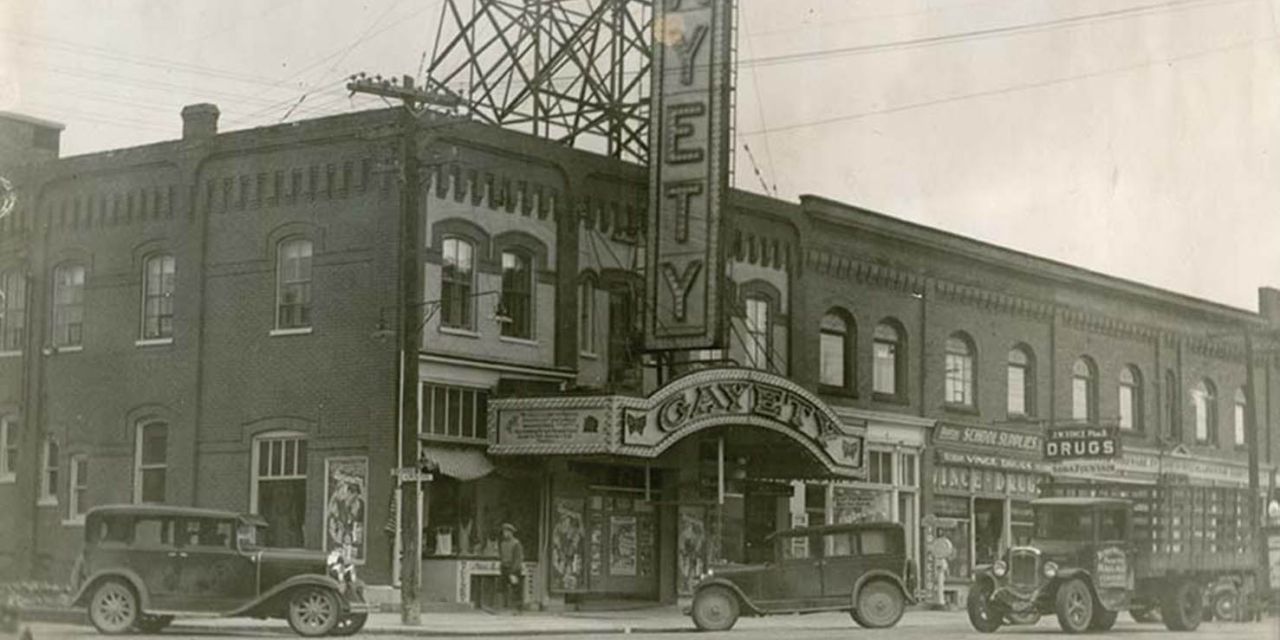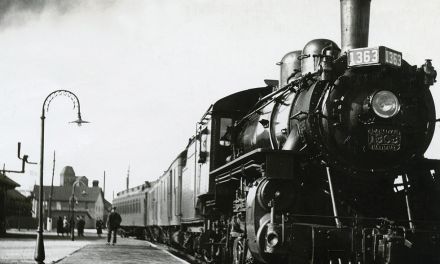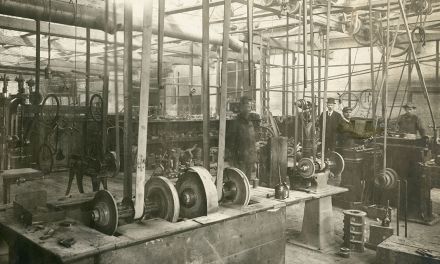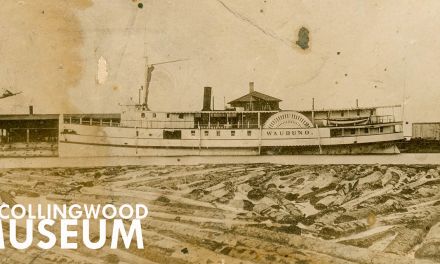The Gayety Theatre sign towers above in this 1937 photograph, with Vince Drug Store’s signage visible a few storefronts down. Collingwood Museum Collection, X968.551.1; Huron Institute No. 2712.
The Brightest Spot in Town
Script by Ken Maher, Stories from Another Day, a Collingwood Museum Podcast.
Photos courtesy of the Collingwood Museum.
On December 13, 1928, Collingwood’s Gayety Theatre lit up the night sky, marking the start of a new era in entertainment. For nearly a century, it has remained a cherished local landmark.
It was dark and more than a little cold. A damp cold, so the mother held her little one close to her front, trying to block the wind coming down the main street from the harbour. She was doing her best to hear the words of the mayor, standing there under the marquee beside the Russes. It was difficult, though. And not just because her little one was squirming with boredom. The real distraction was the young men beside her. They continued to whisper and chuckle, making spurious comments throughout the entire ceremony. Apparently, they found the whole thing rather amusing. Obviously, they knew all about where this new sign had come from, and they were intent on letting others around them know it too. It was all rather distasteful, she thought.
“And so, on the occasion of this grand opening of the new Gayety Theatre, a centre for family entertainments…” the mayor began from his podium up front. “We liked the old one better!” called out one of the young men, garnering a look from the mothers around him. “This is taking too long,” broke in another of the bunch. “Can’t we just step lively, girls?” he spoke out loudly, to the guffaws of his compatriots. This time, more than a few of the women turned to look at the young men, and a father or two made it clear enough was enough. Some things were not for young ears. But that was as far as the heckling went, for at that very moment, the speeches ended, and a smattering of polite and somewhat muffled clapping began. Then, with a click and a hum, the entire night sky lit up like broad daylight, and the only sound to be heard throughout the gathered crowds was an audible gasp. This was followed, after a moment, by a wave of mingled awe, delight, and amazement as people shaded their eyes and looked around in wonder. Stepping forward, Sam Russ called out, “Welcome to the Brightest Spot in Town!” And no one could say otherwise.

Colourized postcard of Hurontario Street, featuring the Gayety Theatre at the corner of Hurontario and Ontario Streets. Collingwood Museum Collection, X969.543.1.
The day was December 13, 1928. It was 7:30 pm sharp as Mayor Arthur led the grand lighting that marked the reopening of a local landmark, The Gayety Theatre, a landmark that would for decades to come quite literally be the brightest spot in town. You see, what everyone had gathered to witness was the brand-new sign, a wonder to behold: 1,500 incandescent lights making up a sign so enormous that it required a special scaffold structure on the roof to hold it all up! It was by far the brightest thing on Collingwood’s main street well into the 1940s. So bright, in fact, that the sign was visible all the way from the top of the Escarpment. The sign itself, as the young men in the crowd could so gleefully tell you, came from a Toronto burlesque club of the same name, where the marquee provocatively heralded the “Step Lively Girls” to all the city’s passersby. But here in Collingwood, the sign’s origins would soon be forgotten as it truly became a beacon of family entertainment for nearly a century.
The building there at 161 Hurontario was originally a hotel called the True Blue House. Then, in 1911, it became TheEmpire Theatre, designed to hold vaudeville shows, cinema, and community events. However, by 1918, troubles such as the wartime rationing of coal (what was called “heatless days”) and further closures due to the Spanish Flu outbreaks began to cut into the theatre’s ability to make a profit. These troubles lasted well into 1920, by which time it was simply too late to recover. By 1922, The Empire Theatre was bankrupt and sold off. A new interest bought it and opened it as The Rex Theatre, which also fell to the same economic pressures only three years later. In 1925, The Rex Theatre was purchased by Sam Russ and ran under that same moniker until the remodelling, renaming, and reopening as The Gayety in 1928.
The very next year, Sam Russ, proprietor, became the talk of the town again when it was made known he was set to usher in a new era in local entertainment. As the newspapers of the day would describe it, “Through the medium of the Vitaphone presentations, it will be possible to present great stage successes on the screen in a more lavish and sumptuous manner than was ever possible on the stage.” Indeed, The Gayety Theatre here in Collingwood was the very first theatre north of Toronto to install “talkies,” and the very first town of its size in all of Canada to enjoy them. It would cost Mr. Russ an investment of $10,000 in new equipment. H.G. Dillon remembers being at the theatre for an early demonstration. As he recounts in Reflections: An Historical Anthology of Collingwood, “…the sound was recorded on large discs and played on turntables like a phonograph record. I remember seeing them in the area just behind the seats where they could be easily viewed [in awe, one must assume] by the patrons as they both came in or went out.”

True Blue House, circa 1872, operated as a hotel at the corner of Hurontario and Ontario Streets before the current brick building was constructed. Collingwood Museum Collection, X969.746.1.
Not content to remain idle, on July 1, 1937, Mr. Russ would introduce local movie-goers to another wonderful first with the advent of a “scientifically air-conditioned” experience. And thus, began a longstanding summertime tradition of beating the heat for a couple of hours by seeing a show. Even as a young boy myself, I can still remember that during many a long, hot summer, the only air-conditioned relief was at the movies. Well, that, or in the frozen food aisle of a local grocery store.
Over the years, so many iconic films and acts graced The Gayety Theatre’s stage. Movie classics like Snow White and the Seven Dwarfs, The Wizard of Oz, and Gone with the Wind delighted crowds of Collingwood residents right alongside such acts as Mutt and Jeff, The Dionne Quintuplets Reunion, and military variety shows such as The Dumbells, and The Canadian Armoured Corps’ “The Black Berets.” But most thrilling, and by far the biggest hometown breakout favourite, held over to rave reviews, was the performance entitled “The Gay Nineties” (that is, the 1890s) starring Collingwood’s own Jessica Hodgson Kennedy, whose story is a worthy one for another day.
The Gayety sign came from a Toronto burlesque club of the same name, where the marquee provocatively heralded the “Step Lively Girls”.
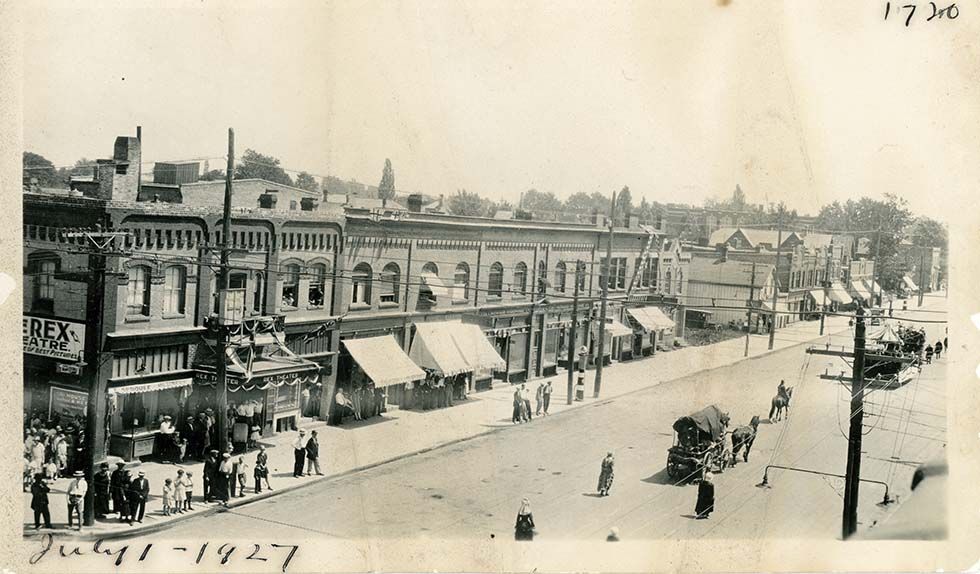
The Rex Theatre at 161 Hurontario Street operated until it was renamed The Gayety Theatre in 1928. This photograph was taken during the Dominion Day Parade on July 1, 1927. Collingwood Museum Collection X971.922.1; Huron Institute No. 1720.
On this day, we’ll stick with the Russes and the family friendly business they worked so hard to maintain for all those years. Local Terry Geddes fondly recalls that Mrs. Russ held a special place in many a youngster’s heart here in town, maybe even more so than her husband Joe. As he remembers in Butchers, Bakers and Building the Lakers, “Rose Russ was one of the greatest ladies this town has ever had. [She] would let us into the show at The Gayety for nothing. There were times when we paid, if we had the money, but she knew if things were, you know—and she would let us in. She was really good to us.” Besides letting children in for free, it was also a well-known secret among the youth of this town that the Russes were not always very strict about how many shows you could stay and watch for your initial ticket price. And what’s more, many times through the years, admission would be free for young or old alike with a donation of a can of food for the poor.
Another local, Jim Trott, tells of how the Russ family had a special deal arranged with the Easter Seals Blue Mountain Camp. This was the first Canadian camp for children with physical disabilities, generously supported by the Ontario Rotary Clubs. As Jim also remembers in Butchers, Bakers and Building the Lakers, “This was after the polio epidemic, so it was quite common. I used to help on Saturdays to take these kids to the matinees. Some of them used crutches, but there were always about six of them who were on stretchers. We had a half-ton truck that had a long, flat bed, open in the back. Every Saturday, I would go up to the camp and pick up these kids. The truck could fit about five of the stretchers on the truck bed crosswise. The kids were dressed up but lying on those stretchers. And we’d drive them down to the show in the open truck like that. They had a great time riding down, hollering and waving at the people, and the people hollering back. We’d take them to the side door of the theatre.
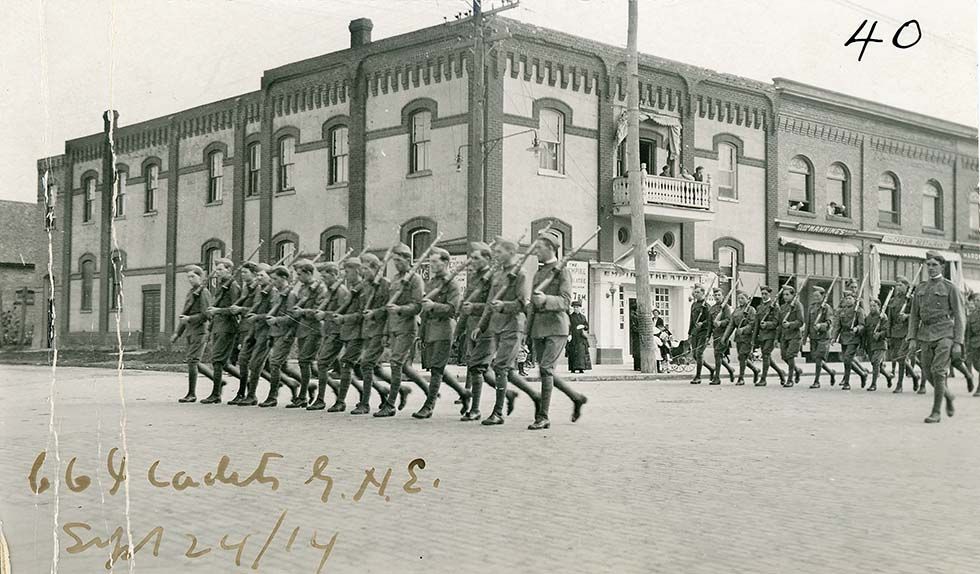
C.C.I Cadets march past the Empire Theatre during the Great Northern Exhibition on September 24, 1914. Collingwood Museum Collection, X974.593.1; Huron Institute No. 40.
We used to lay the stretchers on the seats, with the seat all slanted, and the kids could lie down and watch the show. We did that for quite a few years.” Now, I think it goes without saying that such a ride wouldn’t happen nowadays, and rightly so. Or at the very least, the only one waving would be the police officer as they pulled you over to hand out the ticket. But no one at the time seemed to mind too much, and, as Jim said himself, the children probably liked the ride as much as the movies.
Well, for three generations, the Russ family owned and operated the theatre. That’s 92 years of entertainment. But in 2003, after 80 years of movies, The Gayety closed its doors to little press, fanfare, or celebration. But then it was purchased, refurbished, renovated, and reopened the same year for both stage (with new dressing rooms) and screen under a new owner, Mr. Sid Dickinson. Again, in 2013, this beautiful jewel of a theatre was given renovations and a refocusing of its operations, which, according to the operations manager of the time, Kai Hulshof, would seek to bring back a family focus to the theatre.
The sign with a questionable past remained brightly shining in its place until 1958 when a much smaller and differently shaped sign—the one that we are familiar with today—took its place. But by the time the behemoth of brightness came down, the place of The Gayety Theatre as an important part of family life in Collingwood was already well and firmly established. And so many people still have fond memories tied up in The Gayety Theatre to this day that it is safe to say it remains one of the brightest spots in town even now. E

